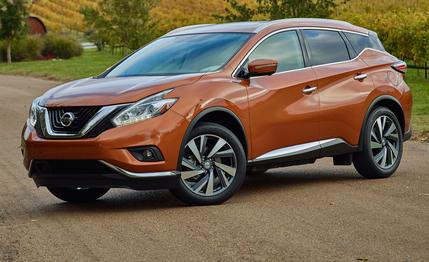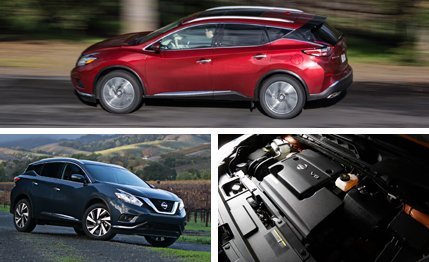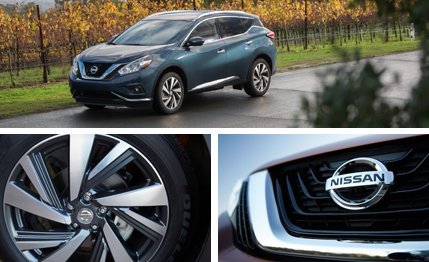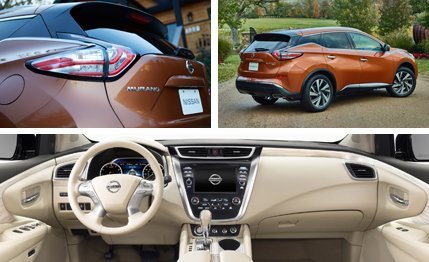
 First Drive Review
First Drive Review
When Nissan showed its bold Resonance concept at the 2013 Detroit auto show, there was no question that the car forecast the third-generation Murano. That vehicle is now here, appearing in production metal and plastic with most of the show car’s intent intact. Nissan execs are proud of their new “flagship crossover,” as they call the 2015 Murano, throwing around further clichés like “concept car for the street” and talking about how much the interior resembles a “lounge on wheels.” Which is by an appropriate measure less temerarious than the concept’s press release, which proclaimed that designers had drawn inspiration from “the futuristic allure of hypersonic travel.”
Alas, travel in the new Murano is slower—and decidedly familiar. Nissan’s two-decades-old VQ engine drives the wheels through a continuously variable transmission, just like every Murano to come before. Displacement remains at 3.5 liters, as does the Murano’s 260 horsepower and 240 lb-ft of torque. While we retain a fondness for the naturally aspirated VQ, in this era of ubiquitous turbocharging and rampant power escalation, 260 horses no longer seems like a lot. It is enough, however, to adequately motivate the Murano, at least for those drivers looking to simply get from A to B. The transmission remains the weak link for enthusiasts, although the Xtronic CVT now has a manual shift mode that imitates a conventional automatic. We might find this more rewarding if the Murano offered shift paddles instead of requiring the driver to tug at the console-mounted shifter.


With its sheetmetal curving differently for 2015, the Murano’s dimensions and priorities have shifted a bit. While the wheelbase remains unchanged at 111.2 inches, length increases by 2.9 inches to 192.8. Cargo capacity benefits, growing to 39.6 cubic feet. The Murano is also wider and lower, losing some ground clearance and seeing its angle of approach cut by more than half. Nissan has finally come to the obvious conclusion that off-road ability has dropped below even AM radio on crossover buyers’ lists of must-have features. Predictably then, the Murano no longer includes a locking mode for its front-wheel-biased all-wheel-drive system, or even a torque-split display like the one included in the Pathfinder.
For the first time since its original launch 12 years ago, however, the Murano is on the cutting edge of styling. Oddly enough, it most resembles the basic design of the BMW i3, though larger and more fully realized. So the Murano is not exactly sexy, but it is different. Sculpted sides and taillights that resemble boomerangs give it an athleticism that’s somewhat at odds with a bulbous front end. The “floating roof” from the concept is executed by means of several black plastic exterior trim pieces that seem like a triumph of form over function. But Nissan has managed to drop the Murano’s claimed coefficient of drag from 0.37 to 0.31, in part by designing the hood such that it kicks up at its trailing edge, thereby routing air smoothly up over the roof.
We noticed this because the lip sits so far forward of the windshield that the cowl is enormous, which looks rather strange from the driver’s seat. So function clearly had its spot at the table; the Murano’s EPA combined fuel-economy rating sees a dramatic improvement from 20 mpg to 24 regardless of the number of driven wheels. This reflects a clear corporate commitment to boosting mileage. Nissan had the largest improvement in average fuel economy of any carmaker from 2012 to 2013, according to a recent EPA report.


Like other Nissans, the new Murano has also slimmed down, to an average stated weight of less than 3900 pounds. The four trim levels (the familiar S, SV, SL, and a new Platinum designation that replaces the old top-of-the-line LE) are each available with either front- or all-wheel drive; listed weights range from as little as 33 pounds lighter for the base model to as much as 146 pounds lighter for the four-wheel-drive SL.
From behind the wheel, the Murano seems less of a futuristic concept than just a really nice Nissan. The switchgear is common Nissan stuff, and the “NASA-inspired Zero Gravity seats” from its Altima platform-mate are now standard on the Murano, both in the front and second row. While they may not rank with Tang and Velcro, they are indeed comfortable.
The interior is trimmed with unapologetically plastic accents in one of two patterns that are tied to the interior color choice. One resembles nothing so much as modern bathroom tile, while the other looks similar to the silver wood that graces certain Mercedes-Benz S-classes. Novel, yes, but both finishes are far more convincing and aesthetically pleasing than the fake carbon fiber or metal-look plastic that many automakers use to connote upmarket aspirations.


Acoustic laminated glass and plenty of sound deadening contribute to a quiet cabin, one that is mostly free of road noise. To the average buyer, this is where the new Murano makes its best justification as a premium product. An upgraded infotainment system with smartphone integration and new safety technologies like emergency braking and a radar-based frontal-crash warning system tick all-important boxes on the features sheet.
The Murano is priced right on top of its larger, three-row Pathfinder sibling, starting at $30,445, with a top-of-the-heap Platinum grazing the $40,000 mark. All-wheel-drive models command $1600 more. Nissan would have us believe that all that design is worth the money; we might posit that the Murano’s superior driving dynamics are more deserving of your hard-earned dollars. We are impressed with the nicely weighted steering, the well-damped suspension, and the firm brake pedal. Just as its predecessor, the new Murano does a nice job of toeing that fine line between isolating and involving. Now that’s a concept that truly resonates.